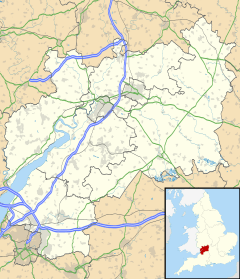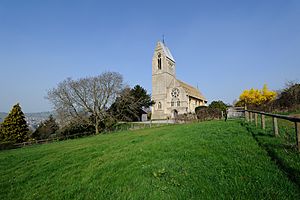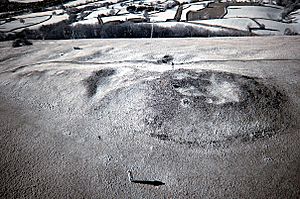Selsley facts for kids
Quick facts for kids Selsley |
|
|---|---|
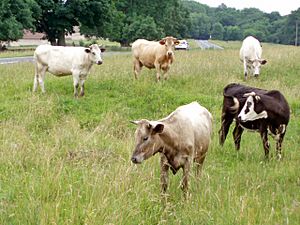 Selsley Common |
|
| Civil parish |
|
| District |
|
| Shire county | |
| Region | |
| Country | England |
| Sovereign state | United Kingdom |
| Police | Gloucestershire |
| Fire | Gloucestershire |
| Ambulance | Great Western |
| EU Parliament | South West England |
Selsley is a small village in Gloucestershire, England. It's part of the King's Stanley area, near the town of Stroud. Selsley has about 175 houses spread out on the edges of a hill called a Cotswold spur. It's located about 3.2 kilometers (2 miles) south of Stroud.
Contents
Selsley's Past and Important Events
Selsley Common is a very old place. However, the name "Selsley" for the village itself only started being used after 1863. Before that, the area now known as Selsley West was made up of smaller groups of houses called hamlets. These included Stanley End, Picked (or Peaked) Elm, and The Knapp.
First Hot Air Balloon Flight
Selsley was part of an exciting event in 1785. On October 19, James Sadler, a famous balloonist from Oxford, landed his hot air balloon in Stanley Park. This was the first-ever balloon flight from Stroud! It's believed that around 40,000 people watched this amazing sight.
Chartist Rally on the Common
Selsley made news again in 1839. On Tuesday, May 21, a large meeting called a Chartist rally took place on Selsley Common. About 5,000 people gathered there to support the Chartist movement, which was fighting for more rights for ordinary people.
Homes in Selsley
Stanley Park is a large estate and grand house in Selsley. It dates back to the time of Elizabeth I, a queen of England. The house was rebuilt in the mid-1700s and then changed again in 1850 when Samuel Marling bought it. In 1952, the Marling family sold the house and land. The main house, which was already split into apartments, is a special building protected by law. Today, only a few homes inside the old walls of Stanley Park use its postal address.
Most of the older houses in Selsley were built in the 1700s and 1800s. You can also see many newer homes from the 1900s mixed in.
Old Paths and Tracks
Water Lane runs through the village. This is a very old track that goes all the way to North and South Woodchester and then on to Bath. In some places, the banks of the lane are ten feet high, covered with hedges of hawthorn, blackthorn, ash, and beech trees. Spring water flows along both sides of the lane where the type of rock changes.
Selsley's Landscape
The western side of Selsley drops down hundreds of feet to the flat Severn Valley. Beyond the valley, you can see the Black Mountains and the Brecon Beacons in Wales. On this steep hillside, there's also a Bronze Age barrow, which is an ancient burial mound.
All Saints Church
Next to the old manor house is Selsley Church. The Marling family had it built in the mid-1800s. It was designed by George Frederick Bodley in the French Gothic style. The beautiful stained glass windows in the church were some of the first works by famous artists like William Morris, Rossetti, Webb, Ford Madox Brown, and Burne-Jones. The church's design was inspired by a church in Marling, Italy, which is where the Marling family got their name.
One of the names on the village's War Memorial is Ernest Rigsby, who died in the First World War. He is also remembered on a special plaque inside the church. Corporal F.E. Rigsby was from the nearby village of Woodchester. He is remembered in Selsley because he was engaged to the vicar's daughter, Gabrielle West. The Selsley memorial uses his second name, which only his family and close friends used.
Selsley Common
History of the Common
People have always worked hard to protect Selsley Common from being fenced off. The first recorded fight to keep it open was in Saxon times, many centuries ago. In the 1800s, there was a lot of public anger when people tried to enclose the common.
There is one small area that did get fenced off, known as 'Dead Man's Acre'. The story says a man was told he could have as much land as he could fence in one day. But the effort was too much, and it killed him. This story might not be true, as it's similar to old tales like How Much Land Does a Man Need? by Leo Tolstoy.
You can still see the remains of old quarries scattered across the common. These were once used to get stone for building local houses and walls. Smaller dips in the ground are what's left of a medieval soldier's camp, identified in 1942. You can also still see the old tracks used by the quarry wagons.
Special Protected Area
| Site of Special Scientific Interest | |
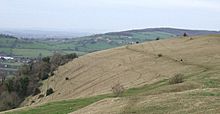
Selsley Common
|
|
| Area of Search | Gloucestershire |
|---|---|
| Grid reference | SO829030 |
| Interest | Biological/Geological |
| Area | 39.4 hectare |
| Notification | 1966 |
Selsley Common is a special place called a Site of Special Scientific Interest (SSSI). It covers about 39.4 hectares (about 97 acres) and was given this special protection in 1966. It's a large open area that is home to many rare plants and animals. In the summer, you can hear birds singing and cows grazing, as local people still have the right to let their cattle feed there.
The common and village are located in the Cotswold Area of Outstanding Natural Beauty. The ground here is made of Jurassic limestone from the Cotswolds. This type of ground helps many different kinds of plants grow. Leigh’s Quarry, which is in the southern part of the SSSI, is very important for studying geology (the study of rocks and the Earth).
Selsley Common is listed in the local plan as both an SSSI and a Regionally Important Geological Site (RIGS).
Geology of Selsley Common
The quarry on Selsley Common shows one of the best examples of rocks from the Middle Jurassic period in the southern Cotswolds. You can see layers of Oolite Marl, Upper Trigonia Grit, and Clypeus Grit. This site also has a great example of a hardground. This is a thin layer of rough limestone that formed when the environment changed a long time ago.
Amazing Plants and Animals
The grassland on Selsley Common is mostly covered by grasses like upright brome and sheep's fescue. Unlike other commons nearby, it has very little tor-grass. Many different herbs grow here, including rock-rose, common bird's-foot-trefoil, salad burnet, and wild thyme.
You can also find many beautiful orchids, especially in the quarry areas. These include autumn lady's tresses, green-winged orchid, and fragrant orchid. There are also some areas with hawthorn bushes and a few ash trees.
This special habitat supports many small creatures, including a type of snail called Abida secale, and various butterflies. Some of the butterflies you might see here are the small blue, grayling, and Duke of Burgundy fritillary.


